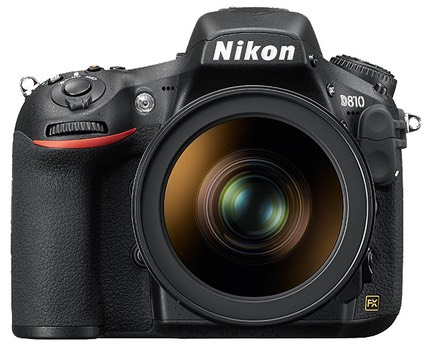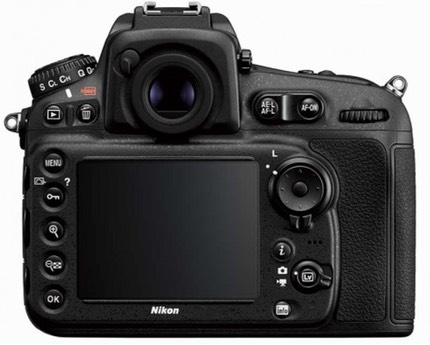(news & commentary)

Nikon today announced a mid-term update to the two D800 models, the D810. The new camera replaces both earlier cameras and is essentially equivalent to a D800E with some modest updates. Here are the key differences:
- A new version of the 36mp sensor, without the AA filter; the ISO range is expanded to 32-51200, with the normal range now 64-12800 (older camera was 100-6400)
- EXPEED4 processor, includes better moire suppression, the sRaw capability similar to the D4s (in this case, 9mp files are created)
- The group autofocus addition first introduced on the D4s
- A new rear 3.2” LCD with 1.3m dots (up from 921k)
- Frame rate improved to 5 fps (6 fps in 1.2x and DX crop, 7 fps with MB-D12)
- Live View now utilizes an electronic first curtain shutter, which minimizes shutter shock
- Video now supports 1080P/50/60
- A slightly lighter (1/2 ounce, 20g) and improved camera body, with metering and bracketing buttons moved and a slightly changed right hand grip, and the three side doors over the connectors are the newer style
- New highlight preservation metering mode
The D810 will sell for US$3300 and be available in late July.
First things first: D800 and D800E users need not panic. There’s nothing in the new camera that just calls out “upgrade now” to you folk. On the other hand, it does show that Nikon is paying some loving attention to one of their more successful high end products. The question is whether this is the right attention in the right places.
The autofocus and frame rate changes are nice-to-haves. Both will make an already highly capable DSLR just slightly better, and while “slightly” doesn’t always seem like enough to some, I’ll take positive steps every time. I do think, however, that these types of improvements tend to show that we shouldn’t expect a D4x any time soon, which is disappointing. Though perhaps Nikon is going to use the upcoming Sony 54mp sensor in a D4x to re-establish a new watermark for the truly high end DSLR.
Still, I’m not optimistic on the D4x front at the moment. Nikon seems to be poking around at various different targets and only upgrading cameras that have known successful pedigrees (though where the D300s replacement is, no one seems to know; you’d think it would be the highest priority upgrade project at Nikon). While I still want a D4x, I’m just thinking more and more that the D800 is what I have to live with. That’s fine. Not quite the body and battery life I want from my main camera, but my D800’s have already lived through a few round-the-world batterings, and extra batteries aren’t that difficult to carry.

Nikon has once again managed to Move the Cheese for all of us on a few things. The metering dial now moves from being around the AE-L/AF-L button to being a button on the left top dial cluster, which in turn moves the BKT button to a new position near the flash button. Why? Exactly what purpose did that serve? It means that if you use a D800 as a backup to a D810, you have to know which camera is in your hands or you probably slow down. The problem with these types of moves is you can’t win. For as many folk who think it’s a good idea, you’ll find as many (or more) that think it’s a bad move. Cheese moving is annoying to us long time loyal Nikon shooters. If something is broke, fix it. But this wasn’t broke; it shouldn’t be fixed.
Meanwhile, we also get another info button (the i button), to better match the UI of the most recent cameras, I guess.
I suspect that a lot of folk will get all atwitter (or is it all Twitter? ;~) about the sRAW capability. Get over it: it’s not raw. It doesn’t save you all that much space on cards over the 12-bit Compressed NEF. I just don’t see the point of it other than to create a marketing check box that matches Canon’s.
Likewise the new video capabilities just don’t interest me all that much. I’ve already backed away from using my Nikon DSLRs for video work; there are just too many video-savvy alternatives out there that really don’t cost that much, and the video world is already centering around the NBT (Next Big Thing): 4K. Sure, it’s nice to have 50 and 60 fps added to the 1080P settings just in case I use the D800 for video in a pinch, and it’s also nice that we can now record both compressed video in the camera at the same time as streaming uncompressed to an external recorder, plus we can now record a flat profile for video, but these aren't something that I see really adding any tangible excitement to the camera.
Not having 4K will upset a lot of folk and rally the Panasonic and Sony fan boy teams into a frenzy. But this is a 36mp sensor, folks. You’re only going to get video by downsampling, so the 36mp sensor will never be optimal for video until we have much more bandwidth inside the cameras and can deal with the full sensor for every frame. You’re much better off with sensors that use all the pixels directly for 4K, in my opinion. It doesn’t strike me that D800 users were all that into video, anyway, despite Nikon’s attempts to promote its video capabilities. I prefer the video off my D4 to that off the D800, by the way: fewer artifacts.
Finally, there’s the name. Nikon’s caught themselves in an interesting quandary. It seems they want to now increment the second digit of a camera on an update (D7000 -> D7100, D600 -> D610, D800 -> D810, etc.). But the pro cameras and Nikon 1 cameras don’t have a second digit ;~). And the consumer cameras have incremented to the 3’s instead of the 1’s. So we’ll continue to have somewhat confusing model designations that need a scorecard to interpret correctly. Basically, higher is better and/or newer, more letters are better than no letters ;~). Single digit is pro, triple digit is pro/prosumer, and four digit is consumer. This really is a naming scheme designed by engineers, not marketeers. And the engineers didn’t plan far enough ahead to accommodate all the differences they would create.
Overall, I’m very happy to see a mid-term adjustment to the D800. On the other hand, we saw one with the D300 and look what happened there. Mid-term became “forever.” Still, there are lots of small tweaks that make an already great camera even better, so I’m happy.
Support this site by purchasing from this advertiser:





